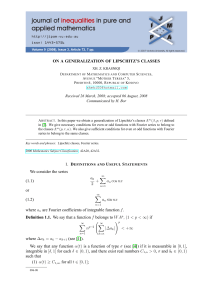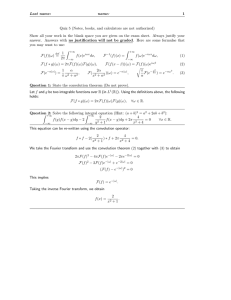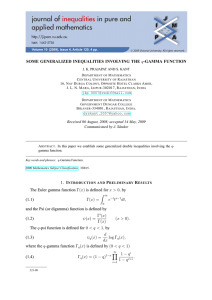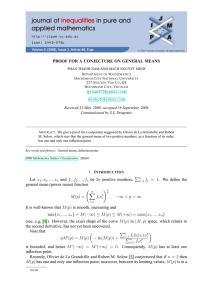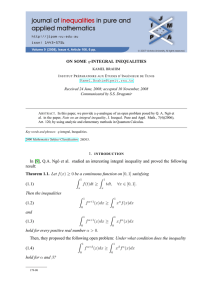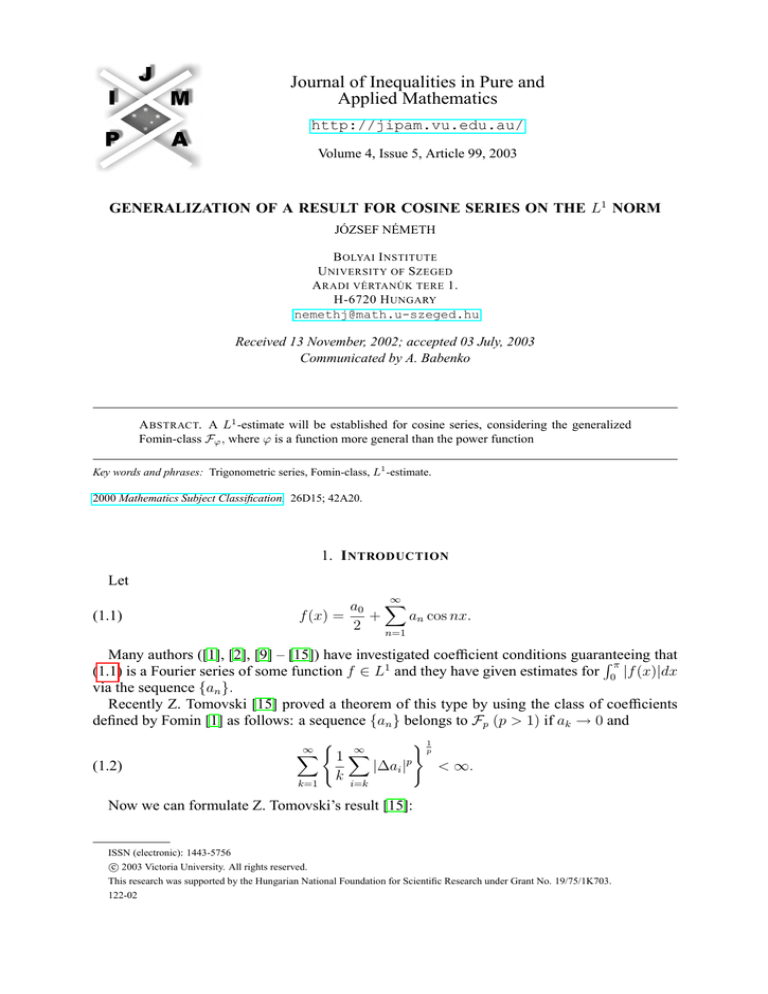
Journal of Inequalities in Pure and
Applied Mathematics
http://jipam.vu.edu.au/
Volume 4, Issue 5, Article 99, 2003
GENERALIZATION OF A RESULT FOR COSINE SERIES ON THE L1 NORM
JÓZSEF NÉMETH
B OLYAI I NSTITUTE
U NIVERSITY OF S ZEGED
A RADI VÉRTANÚK TERE 1.
H-6720 H UNGARY
nemethj@math.u-szeged.hu
Received 13 November, 2002; accepted 03 July, 2003
Communicated by A. Babenko
A BSTRACT. A L1 -estimate will be established for cosine series, considering the generalized
Fomin-class Fϕ , where ϕ is a function more general than the power function
Key words and phrases: Trigonometric series, Fomin-class, L1 -estimate.
2000 Mathematics Subject Classification. 26D15; 42A20.
1. I NTRODUCTION
Let
∞
(1.1)
a0 X
f (x) =
+
an cos nx.
2
n=1
Many authors ([1], [2], [9] – [15]) have investigated coefficient conditions guaranteeing
that
Rπ
1
(1.1) is a Fourier series of some function f ∈ L and they have given estimates for 0 |f (x)|dx
via the sequence {an }.
Recently Z. Tomovski [15] proved a theorem of this type by using the class of coefficients
defined by Fomin [1] as follows: a sequence {an } belongs to Fp (p > 1) if ak → 0 and
( ∞
) p1
∞
X
X
1
(1.2)
|∆ai |p
< ∞.
k i=k
k=1
Now we can formulate Z. Tomovski’s result [15]:
ISSN (electronic): 1443-5756
c 2003 Victoria University. All rights reserved.
This research was supported by the Hungarian National Foundation for Scientific Research under Grant No. 19/75/1K703.
122-02
2
J ÓZSEF N ÉMETH
Theorem 1.1. Let {an } ∈ Fp , 1 < p ≤ 2, then the series (1.1) is a Fourier series and the
following inequality holds:
Z
π
|f (x)|dx ≤ Cp
(1.3)
0
∞
X
n=1
(
∞
1X
|∆ak |p
n k=n
) p1
,
where Cp depends only on p.
Recently we ([7]) investigated the properties of classes of numerical sequences obtained by
using functions more general than the power functions. Such functions were used first of all
in the works of H.P. Mulholland [5] and M. Mateljevič and M. Pavlovič [8]. The following
definition is due to Mateljevič and Pavlovič.
∆(q, p) (q ≥ p > 0) denotes the family of the nonnegative real functions ϕ(x) defined on
[0; ∞) with the following properties: ϕ(0) = 0, ϕ(t)
is nonincreasing and ϕ(t)
is nondecreasing
tq
tp
on (0; ∞). ∆ will denote the set of the functions ϕ(x) ∈ ∆(q, p) for some q ≥ p > 0.
Using this notion in [7] we defined the following class: a nullsequence {an } belongs to the
class Fϕ for some ϕ ∈ ∆ if
!
∞
∞
X
1X
ϕ(|∆ak |) < ∞,
(1.4)
ϕ
n k=n
n=1
where ϕ is the inverse of the function ϕ.
The aim of the present paper is to generalize Theorem 1.1 using Fϕ instead of Fp , where
ϕ ∈ ∆. Since our goal is to get a result concerning such functions as ϕ(x) = x logα (1 + x) and
not only for functions which are generalizations of xp (p > 1), we therefore need to define two
subclasses of ∆. Namely we use the following definitions: ∆(1) denotes the family of functions
ϕ(x) belonging to ∆(q, p) for some q ≥ p > 1 and ∆(2) is the collection of functions ϕ(x)
from ∆(q, 1) for some q > 1 such that for all A > 0 there exists p := p(A) > 1 satisfying the
condition that ϕ(x)
is nondecreasing on (0; A). It is obvious that ∆(1) ⊂ ∆(2) .
xp
After giving these definitions we can formulate our result which generalizes Theorem 1.1 (if
ϕ ∈ ∆(1) ). Furthermore, it contains the case like ϕ(x) = x logα (1 + x) (α > 0).
2. R ESULT
Theorem 2.1. Let {an } ∈ Fϕ for ϕ ∈ ∆(2) . Then the series (1.1) is a Fourier series and the
following estimate holds
!
Z π
∞
∞
X
1X
(2.1)
|f (x)|dx ≤ Cϕ
ϕ
ϕ(|∆ak |) ,
n
0
n=1
k=n
where Cϕ is a constant depending only on ϕ.
Remark 2.2. In [3] and [4] L. Leindler investigated a relation among classes of numerical sequences other than Fp (see the classes denoted by Sp , Fp∗ , Sp (δ), Sp (A)) and he proved that all
these classes coincide. Later in [7] we defined the classes of sequences Sϕ , Fϕ∗ , Sϕ (δ), Sϕ (A)
exchanging the functions xp to ϕ(x) and showed that all these classes also coincide. Therefore
in Theorem 2.1 the class Fϕ can be replaced by any of the above mentioned classes, if ϕ ∈ ∆(2) .
J. Inequal. Pure and Appl. Math., 4(5) Art. 99, 2003
http://jipam.vu.edu.au/
G ENERALIZATION OF A R ESULT FOR C OSINE S ERIES ON
THE
L1 N ORM
3
3. L EMMAS
Lemma 3.1. ([11]). Let the nullsequence {an } be of bounded variation and
[i/2] ∞ X
X
∆ai−k − ∆ai+k <∞
k
i=2 k=1
then (1.1) is a Fourier series and the following estimate holds:
Z π
∞
∞ X
X
X
[i/2] ∆ai−k − ∆ai+k ,
(3.1)
|f (x)|dx ≤ C
|∆ak | +
k
0
i=2 k=1
k=0
where C is some absolute constant.
Lemma 3.2. ([1]). Let {an } be a nullsequence. Then the following estimate holds:
[i/2] ∞ X
∞
X
X
∆ai−k − ∆ai+k (3.2)
∆(p)
s ,
≤ Cp
k
s=1
i=2 k=1
where
(
∆(p)
s =
) p1
s
1
2s−1
2
X
|∆ak |p
,
1 < p ≤ 2,
k=2s−1 +1
and Cp is a constant depending only on p.
Lemma 3.3. ([5]). If
numbers
Ψ(x)
x
is increasing then for all sequences {an } and {bn } of nonnegative
Pn
Pn
ai b i
a Ψ(2bi )
i=1
Pn i
Ψ Pn
≤ i=1
i=1 ai
i=1 ai
holds.
Lemma 3.4. ([6]). Let ρ(x) denote a nonnegative function increasing to infinity such that ρ(x)
x
is decreasing to zero when x is increasing from zero to infinity. Furthermore, if an ≥ 0, λn > 0
for all n, then
!
!
∞
n
∞
∞
X
X
X
an X
(3.3)
λn ρ
λk ≤ Cρ
λn ρ
ak ,
λ
n
n=1
n=1
k=1
k=n
where Cρ depends only on the function ρ(x).
Lemma 3.5. Let bn ≥ 0 for all n and let ϕ be the inverse of the function ϕ(x) ∈ ∆(2) . Then
P∞
∞
∞
X
X
k=n bk
ϕ
,
(3.4)
ϕ(bn ) ≤ Kϕ ·
n
n=1
n=1
where Kϕ is a constant depending only on ϕ.
Proof. Since ϕ(x)
is decreasing to zero if x → ∞, therefore using Lemma 3.4 and taking
x
ρ(x) = ϕ(x), bn = n · an , λn = 1, we get
!
∞
∞
∞
X
X
X
bk
ϕ(bn ) ≤ Kϕ ·
ϕ
,
k
n=1
n=1
k=n
whence the statement of Lemma 3.5 is obtained.
J. Inequal. Pure and Appl. Math., 4(5) Art. 99, 2003
http://jipam.vu.edu.au/
4
J ÓZSEF N ÉMETH
4. P ROOF
Proof of Theorem 2.1. Let ϕ ∈ ∆(2) and bn = ϕ(|∆ an |). Using Lemma 3.5 and that {an } ∈ Fϕ
we have that
!
∞
∞
∞
X
X
1X
ϕ(|∆an |) < ∞,
(4.1)
|∆an | ≤ K ·
ϕ
n k=n
n=1
n=1
where K depends only on ϕ. It now follows that the sequence {an } is of bounded variation.
Further on, we use the following notations:
)
(
2s
X
1
∆(ϕ)
:= ϕ
ϕ(|∆ ak |) , p0 > 1
s
2s−1
s−1
k=2
denotes a number for which
ϕ(x)
xp 0
+1
↑ on (0; A), where A = sup |∆ak |, and by q we denote a
ϕ(x)
xq
k
(2)
number satisfying
↓ (see the definition of ϕ ∈ ∆ ).
Now we will prove that for any 1 < p < p0 ,
∞
∞
X
X
q/p
(4.2)
2s ∆(p)
≤
2
2s ∆(ϕ)
s
s
s=1
s=1
holds.
Since for ψ(t) = ϕ(t1/p ) the function ψ(t)
is increasing thus using Lemma 3.3 and that
t
q
1/p
ϕ(2 x) ≤ 2 p ϕ(x) we get
!
P2s
P2s
p
q
|∆a
|
ϕ(|∆ak |)
s−1
s−1
k
k=2
+1
(4.3)
ψ
≤ 2 p k=2 +1
.
s−1
s−1
2
2
From (4.3), taking into account that ϕ(cx) ≤ cϕ(x) if c > 1, we obtain
"
!#
!
P2s
P2s
p
q
s−1 +1 ϕ(|∆ak |)
k=2s−1 +1 |∆ak |
k=2
(4.4)
ϕ ψ
≤ 2p ϕ
.
2s−1
2s−1
Since ϕ(ψ(t)) = t1/p so from (4.4) we have
( P2s
) p1
p
|∆a
|
s−1
k
k=2
+1
(4.5)
∆(p)
≤ 2q/p ϕ
s =
2s−1
P2s
k=2s−1 +1
ϕ(|∆ak |)
2s−1
!
= 2q/p ∆(ϕ)
s .
From (4.5), (4.2) immediately follows.
Now we show that
P∞
∞
∞
X
X
s (ϕ)
k=s ϕ(|∆ak |)
(4.6)
2 ∆s ≤ 4 ·
ϕ
.
s
s=1
s=1
P
Since the sequence Us = 1s ∞
k=s ϕ(|∆ak |) is monotone decreasing, we obtain
!
n
n
2s
X
X
X
1
ϕ(|∆ak |)
2s ∆(ϕ)
=2·
2s−1 ϕ
s
s−1
2
s−1
s=1
s=1
k=2
+1
!
n−1
n−1
2X
2X
∞
1X
(4.7)
≤4·
ϕ(Us ) = 4 ·
ϕ
ϕ(|∆ak |) .
s
s=1
s=1
k=s
Setting n → ∞ we have from (4.7) the inequality (4.6).
J. Inequal. Pure and Appl. Math., 4(5) Art. 99, 2003
http://jipam.vu.edu.au/
G ENERALIZATION OF A R ESULT FOR C OSINE S ERIES ON
THE
L1 N ORM
5
Collecting (4.1), (4.2), (4.6), using Lemma 3.1 and Lemma 3.2, we get that (1.1) is a Fourier
series and (2.1) is true. Thus Theorem 2.1 is proved.
R EFERENCES
[1] G.A. FOMIN, A class of trigonometric series, Math. Zametki, 23 (1978), 117–124 (Russian).
[2] A.N. KOLMOGOROV, Sur l’ordre de grandeur des coefficients de la serie de Fourier-Lebesgue,
Bull. Acad. Polon. Ser. A, Sci. Math. (1923), 83–86.
[3] L. LEINDLER, On the equivalence of classes of Fourier coefficients, Math. Inequal. Appl., 3
(2000), 45–50.
[4] L. LEINDLER, A note on some classes of real sequences, Math. Inequal. Appl., 4 (2001), 53–58.
[5] H.P. MULHOLLAND, The generalization of certain inequality theorems involving powers, Proc.
London Math. Soc., 33 (1932), 481–516.
[6] J. NÉMETH, Generalization of the Hardy-Littlewood inequality. II, Acta Sci. Math., 35 (1973),
127–134.
[7] J. NÉMETH, A note on two theorems of Leindler, Math. Inequal. Appl., 5 (2002), 225–233.
[8] M. MATELJEVIČ AND M. PAVLOVIČ, Lp -behavior of power series with positive coefficients and
Hardy spaces, Proc. Amer. Math., Soc., 87 (1983), 309–316.
[9] S. SIDON, Hinreichende Bedingungen für den Fourier- charakter einer trigonometrischen Reihe,
J. London Math. Soc., 14 (1939), 158–160.
[10] S. SIDON, Reihen theoretische Sätze und ihre Anwendungen in der Theorie der Fourierschen Reihen, Math. Z., 10 (1921), 121–127.
[11] S.A. TELYAKOVSKǏI, Integrability conditions for trigonometric series and their application to the
study of linear summation methods of Fourier series, Izv. Akad. Nauk SSSR Ser. Mat., 28 (1964),
1209–1238.
[12] S.A. TELYAKOVSKǏI, Some estimates for trigonometric series with quasi-convex coefficients,
Mat. Sb., 63(105) (1964), 426–444. (Russian)
[13] S.A. TELYAKOVSKǏI, An asymptotic estimate of the integral of the absolute value of a function
given by sine series, Sibirsk. Mat. Ž., 8 (1967), 1416–1422. (Russian)
[14] S.A. TELYAKOVSKǏI, An estimate, useful in problems of approximation theory of the norm of a
function by means of its Fourier coefficients, Trudy Mat. Inst. Steklov, 109 (1971), 73–109. (Russian)
[15] Ž. TOMOVSKI, Two new L1 -estimates for trigonometric series with Fomin’s coefficient condition,
RGMIA Research Report Collection, 2(6) (1999), http://rgmia.vu.edu.au/.
J. Inequal. Pure and Appl. Math., 4(5) Art. 99, 2003
http://jipam.vu.edu.au/


